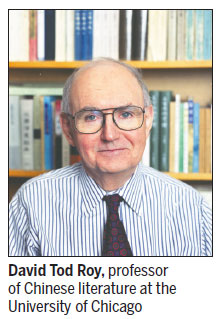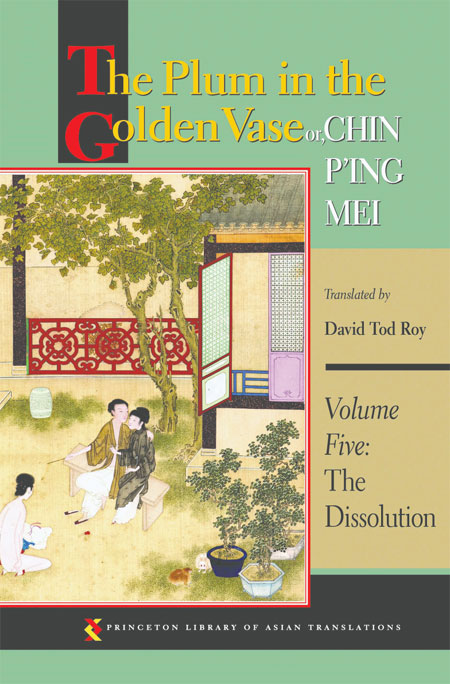Crusading for recognition for 'work of literary genius'
Updated: 2013-04-05 11:53
By Kelly Chung Dawson in New York (China Daily)
|
||||||||
|
The cover of the fifth volume of The Plum in Goden Vase (Jinpingmei in Chinese), a Chinese classic literary work in the 16th century. The book used to be seen as erotic and banned in China for a long time, but David Tod Roy, translator of the book and professor of Chinese literature at the University of Chicago, believes it is the work of a literary genius. Provided to China Daily |

In an office littered with thousands of notes inscribed on stacked paper flash cards, David Tod Roy has labored on what he calls his "life's work" for three decades.
Painstakingly pouring over a 16th-century novel that in woodblock form ran more than 3,000 pages, the University of Chicago professor of Chinese literature has devoted the bulk of his career to the translation and annotation of Chin P'ing Mei, or The Plum in the Golden Vase.
Written anonymously, the work focuses on a corrupt mobile merchant and his harem of six wives and concubines. While the book is most often recognized for its erotic realism, The Plum in the Golden Vase is a landmark book not only in the history of Chinese literature but world literature, Roy said. Its role in shaping the later (and arguably most famous of all Chinese novels) Dream of the Red Chamber is undeniable, he said.
"It's an extremely significant book," he said. "Every time I've taught this book, I've become more convinced of its importance and impressed by its rhetorical sophistication. Some people have viewed it purely as an erotic novel, but at the time it circulated among members of the educated elite and the literary avant-garde, who all recognized it for being a work of literary genius."
He first became aware of the novel as the teenage son of Presbyterian missionaries in Nanjing and Shanghai, where he studied at the Shanghai American School with his brother, former US ambassador to China J. Stapleton Roy. He later taught the work at Princeton University and the University of Chicago.
The Plum in the Golden Vase was ground-breaking for its focus on ordinary life in a middle-class family; earlier Chinese literature had focused only on emperors, powerful officials or figures in mythology. The book's incredibly detailed descriptions of daily life, dress, cuisine, legal malfeasance and yes, sexual activity - all make it a "rich sourcebook for any student of 16th-century society," Roy said.
As a language resource, the book is also remarkable for having documented the era's vernacular, from the refined speech of the elite to street slang and cuss words, he said.
But in keeping with a tradition that is entirely Chinese, the novel is more than the story at its surface, Roy said.
In Chinese literature, poets and novelists have often veiled their criticisms by not only changing the time period depicted in their work, but also through the use of metaphor and allusion. In The Plum in the Golden Vase, the merchant at the center of the plot likely stands for the emperor at the time the author was writing, Roy said. The six women of his household represent the six bureaus at the head of the imperial bureaucracy.
"The ancient Confucian belief was that if an emperor led a moral life, that would have a favorable effect on all of society, with the opposite being equally true: if the emperor was immoral, that would have a bad effect on the morals of the entire society, and you see that in smaller form with this family in the book," Roy said. "The author clearly believed that Chinese society at the time was corrupt from top to bottom, but employed criticism by indirection, as many writers did."
Although the novel was previously translated by Clement Egerton in 1938 (under the title The Golden Lotus), that version appeared partially in Latin (due to the sexual nature of the novel) and was more of a paraphrase of the book. With this translation, Roy has attempted to remain faithful to the original novel's text.
In the New York Review of Books, critic Jonathan Spence wrote: "Roy has made a major contribution to our overall understanding of the novel. He has annotated the text with a precision, thoroughness and passion for detail that makes even a veteran reader of monographs smile with a kind of quiet disbelief."
David Rolston, a professor of Chinese literature at the University of Michigan who studied with Roy at the University of Chicago, noted the translator's mastery of both Chinese and English vocabulary and style.
"He is incredibly successful in finding dynamic equivalents between the languages," he said. "He has a magnificent control of language that you don't find in younger generations. This book has been a constant companion for him, and it's truly amazing to see someone whose entire career has been focused on one work at this level. Additionally, he has an enormous knowledge of previous literature."
The thousands of pop-culture and literary references that appear in the original novel were mostly uncited. Roy traced and documented the original sources in a way that illuminates the book further than any other study has done, Rolston said. Those sources appear in Roy's translation as footnotes.
Roy compared the author's use of earlier works to the manner in which an artist might create a mosaic, and noted that the author James Joyce also injected his work with the songs and references of his time.
He is extremely pleased with the increased interest in Chinese literature among Western readers, he said. He said that when he was a student, there were only four or five universities in the US with China programs.
"Things have changed very radically in the last half century, and needless to say that's a very good thing," he said.
(China Daily 04/05/2013 page11)

 In Photos: 7.0-magnitude quake hits Sichuan
In Photos: 7.0-magnitude quake hits Sichuan
 Li Na on Time cover, makes influential 100 list
Li Na on Time cover, makes influential 100 list
 FBI releases photos of 2 Boston bombings suspects
FBI releases photos of 2 Boston bombings suspects
 World's wackiest hairstyles
World's wackiest hairstyles
 Sandstorms strike Northwest China
Sandstorms strike Northwest China
 Never-seen photos of Madonna on display
Never-seen photos of Madonna on display
 H7N9 outbreak linked to waterfowl migration
H7N9 outbreak linked to waterfowl migration
 Dozens feared dead in Texas plant blast
Dozens feared dead in Texas plant blast
Most Viewed
Editor's Picks

|

|

|

|

|

|
Today's Top News
Live report: 7.0-magnitude quake hits Sichuan, heavy casualties feared
Boston suspect cornered on boat
Cross-talk artist helps to spread the word
'Green' awareness levels drop in Beijing
Palace Museum spruces up
First couple on Time's list of most influential
H7N9 flu transmission studied
Trading channels 'need to broaden'
US Weekly

|

|








